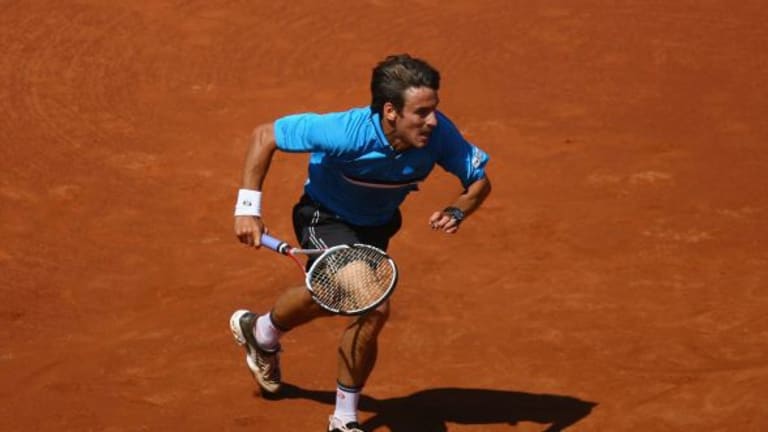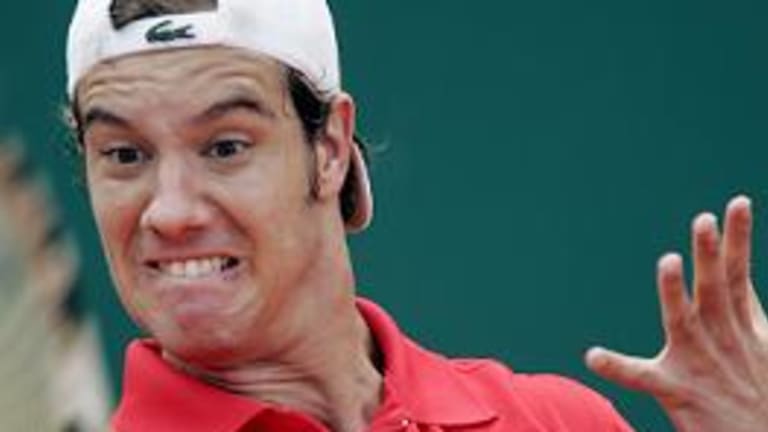By TW Contributing Writer, Asad Raza
[[Mornin', everyone. Well, it was one hail of a virtual Holiday party last night, thanks for dropping by. I'm on my way to Florida but I thought, "What better way to get you all juiced up than by publishing a Greatest Hits piece that really evokes tennis at its best - outdoors, at a storied event, on a pleasing and difficult surface?" So here is one of Asad's posts from the Italian Open, including my original header note. Try to stay on-topic until whatever discussion this engenders runs its course. The Comment tab is relatively short, and it might be fun to review the previous comments (unless Typepad eats them, because I am re-posting this in its entirety. . . Just start adding on at the end of the comment string if that suits you. I'll be back tonight if I can get adequate Internet access at the NBTA]]
-- Pete
**
[[Pete's note: We are very fortunate to have two representatives of the Tribe in Rome this week: Rosangel (taking photos and posting the CC threads) and Asad (aka Ray Stonada). I love this picture of Tommy the Toy Robredo, available at a Toys R Us soon. . .]]
Ciao, Pete! Como siete? Next door, Steve just compared you to everyone's favorite M.C., Virgil, so let's do like Virgil did, and get right to the action:
Sunny, temperate Day Two in Rome shaped up as an exhibition of the many varieties of play on the terra rossa. First up on Stadio Nicola Pietrangeli was an oddity: a match in Rome between two Americans. Andy Roddick, despite his habitually short springtime visits to Europe, was received with warm applause and cheers of "Roe-dique!" He and Mardy Fish began play as though they, too, were bemused to be renewing their rivalry in this unlikely venue: the match's first few games were played at the intensity of a practice session. And Fish certainly needed the practice, losing his first three service games with a series of fairly miserable unforced errors. Neither player's shots had much sting on them.
The childhood friends seem to have settled into a rivalry in which nothing Fish does seems to trouble Roddick, who passed crisply and hit his backhand aggressively against his one-time opponent in a Master's Series final, the 2003 tournament in Cincinnati. Fish cleaned up the error-fest in the second set, but still never made an impression. Why? Because his approach shots sat up on the dirt, giving the serve-and-volleyer no chance to play his style effectively. Roddick cruised to victory, but I have no idea what that portends--this was his most favorable possible opponent in the draw.
Out to the smaller courts: 3, 4, 5, and 6 are sunk into a kind of collective amphitheatre, with pleasantly grassy stone bleachers. (This is Tignor's favorite locale at the Foro Italico, and it's easy to sympathize.) On Campo 6, "Disco" Tommy Robredo demonstrated the value of perseverance on clay, and in tennis in general. Facing a barrage of flat groundstrokes from the lanky Juan Ignacio Chela, who seems to hit down on everything, Robredo simply refused to stop scrapping. He was getting every ball back even if it meant scrambling, shanking a short ball, then deftly counterpunching down the line when Chela would step inside the court to attempt a winner. For a man with such nice hair, T-Robb is not afraid to make haste. By the second set, the treatment broke down Chela's will. Some criticize his game's lack of "heft"; but there's no question that Tommy Robredo plays effective, even classic clay tennis.
On the next court over, Dima Tursunov and Jose Acasuso were demonstrating something Jimmy Arias once told me about how he views contemporary tennis. Arias said that in his day, players had weaknesses and the object was to find a strategy that could exploit them. Today, he continued, players have no glaring weaknesses, which has the effect of making strategy less important than execution--whoever hits the ball better on the day wins.
Tursunov and Acasuso epitomized the theory --it was hard to find any logic to their extended baseline battles. If verbalized, the dialogue was something like: That your idea of a big forehand? [SMACK.] That's what's up!" Points ended with unforced errors off easy balls and winners off of tough ones; there was no sense that errors had been forced or winners set up. Random baselining, you might call it.
Court 3 was occupied by two French doubles partners having a hit-around: immortal Fabrice Santoro and a man by the name of Richard Gasquet. Yes, young Reeshard is still here, and still the owner of that flamboyant backhand (though I admit, Pete, when I see him now, a line of yours always pops into my head: "meretricious flourishes").

